Sabudana Thalipeeth are crispy and soft pancakes made with tapioca pearls (sago), mashed potatoes, ground peanuts and spices. These delicious sago pancakes are often made for Hindu religious fasting or vrat like Navratri, Ekadashi and Mahashivratri. They are also known as Upvasache Thalipeeth in the Marathi language.

About Sabudana Thalipeeth
Sabudana also known as sago or tapioca pearls are white colored small balls or pearls made from the roots of the cassava plant (tapioca, yuca).
Various Sabudana Recipes are often made for Hindu fasting days. Usually I make Sabudana Vada, Sabudana Kheer or Sabudana Khichdi during fasting.
This Sabudana Thalipeeth is also such snack meant for fasting. You could also call this tasty preparation Sabudana Roti.
You can make these sabudana thalipeeth instead of sabudana vada if you don’t want to eat any deep fried snack. Sabudana thalipeeth is a light snack and ideal for people who are fasting.
The way to make the mixture is same as sabudana vada. To make the recipe, you have to first soak the sabudana in water for some hours or overnight. Drain all the water after the sabudana pearls are soaked well enough.
The sabudana is then mixed with mashed potatoes, peanut powder, coriander leaves, ginger, a few spices and edible rock salt.
The ingredients are mixed well and shaped/flattened into round discs, which are then pan fried or roasted on a skillet or tawa.
Serve the Sabudana thalipeeth or Upvasache Thalipeeth with any falahari chutney or raita. I served with vrat ke dahi aloo and tamarind dates chutney.
If you are looking for more Navratri Fasting Recipes then do check:
How to make Sabudana Thalipeeth
Soak Sabudana
1. Pick and rinse ⅔ cup sabudana well, till you get transparent water when rinsing. Soak them overnight or for 8 to 9 hours in enough water in a bowl.
Depending upon the quality of sabudana you can soak them for 2 to 3 hours also. I always soak them overnight as soaking for 2 to 3 hours doesn’t work for the quality of sabudana which I get in my city.
It is very important to soak the sabudana pearls very well. They should be completely softened that you can mash them easily when pressed between two fingers.
There must not be any hardness in the center. Un-soaked or under-soaked sabudana will burst while cooking and also make the thalipeeth very hard in texture.

2. The next day, drain all the water really well. Make sure there is no water in them. It is an important step not to be missed.
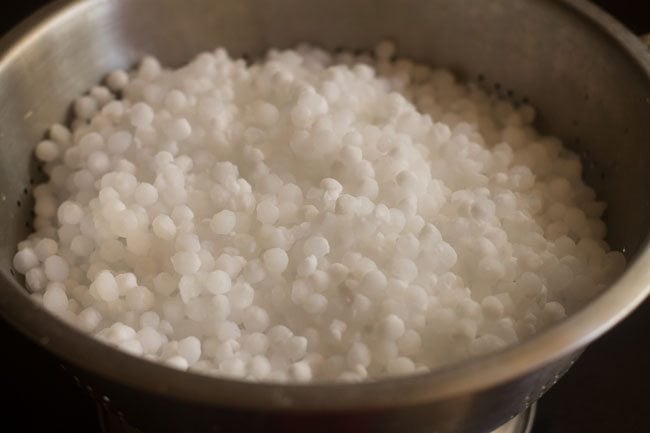
3. Measure and keep all the ingredients ready for making sabudana thalipeeth.

Make Sago Mixture
4. Add 2 large or medium sized boiled, peeled and mashed potatoes to the soaked sabudana. Make sure that the mashed potatoes are warm or at room temperature.
Do not add hot mashed potatoes to the sabudana as this will partially cook the sabudana starch and make the mixture sticky.
You can cook the potatoes in a stovetop pressure cooker, pan, steamer or Instant pot adding water as required.

5. Next add the following ingredients:
- 1 teaspoon sugar
- ½ teaspoon cumin powder
- ½ inch finely chopped ginger
- sendha namak (rock salt) as required
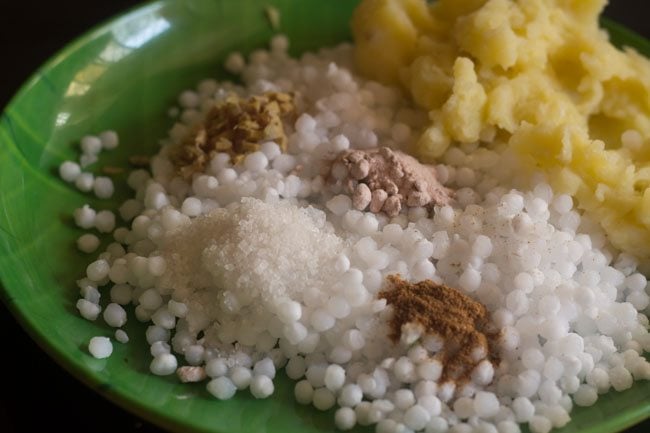
6. Also add ¼ cup chopped coriander leaves and ¼ cup coarsely ground roasted peanuts.
For the peanuts first roast ¼ cup peanuts in a pan or skillet until crunchy. Then once cooled, crush them to a semi-fine powder in a mortar pestle or spice grinder or mixer grinder.

7. Finally add 1 teaspoon lemon juice.
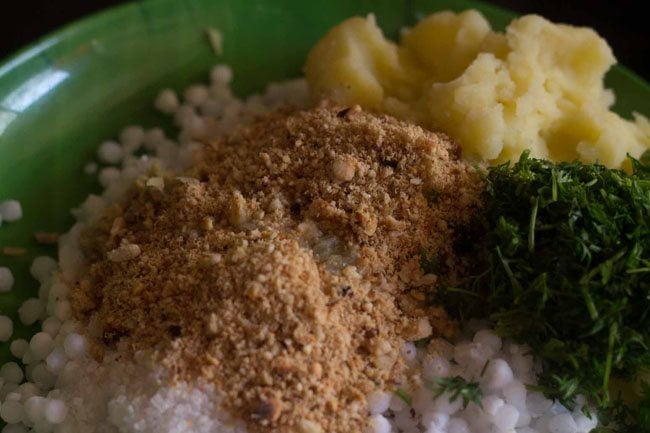
8. Mix very well to make an even mixture.

Make Sabudana Thalipeeth
9. Apply some peanut oil on your palms. Take some portion from the mixture and begin to flatten it with your palms to a round shape. you can also flatten on a ziplock bag. I find it easier to flatten with my palms.
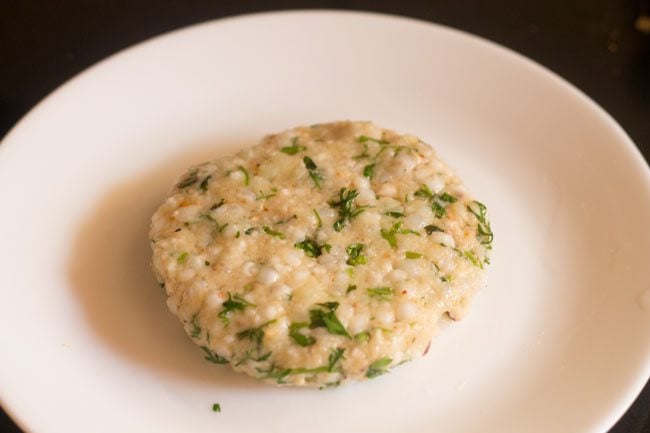
10. Heat a nonstick frying pan or a well seasoned cast iron skillet or tawa. Spread 1 or 2 teaspoon of peanut oil or ghee on the pan.
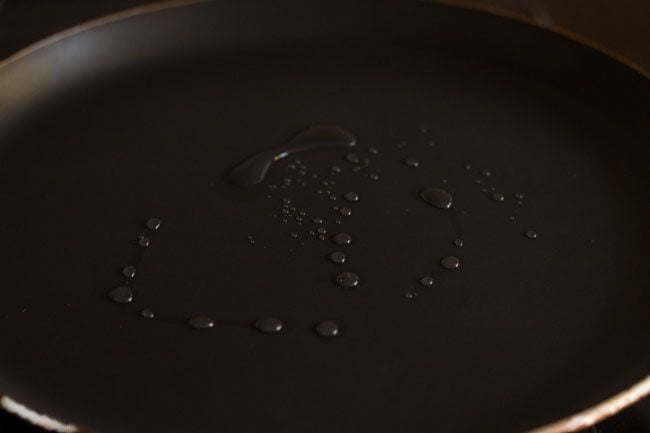
11. Place the flattened round (thalipeeth) on the frying pan. Keep the heat to medium low to medium.

12. When one side is golden and crisp then using a spatula carefully turn over. If you want you can drizzle or spread some peanut oil or ghee.

13. When this side also gets crispy and golden. Then flip once more if needed. You can flip a few times to ensure that the sabudana thalipeeth is cooked evenly and well.

14. If you have a large pan, you can cook 2 to 3 sabudana thalipeeth at the same time.
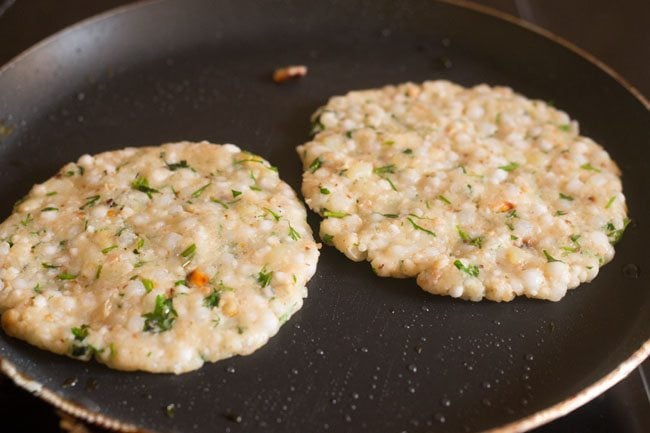
15. Repeat and similarly pan fry the rest of the thalipeeth.
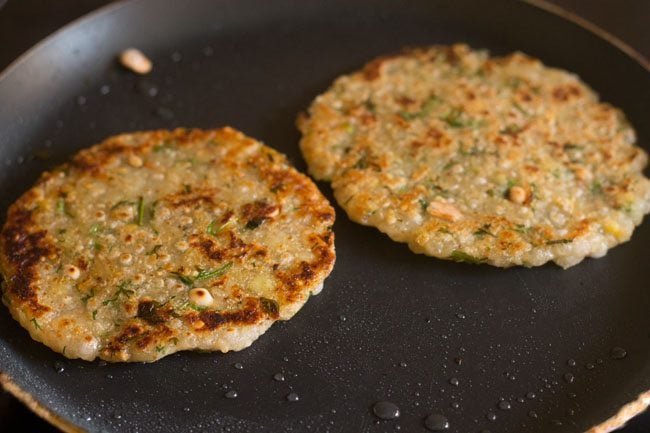
Serve sabudana thalipeeth with a phalahari chutney or raita or plain yogurt. You can also sweetened the curd with some sugar or jaggery.

Please be sure to rate the recipe in the recipe card or leave a comment below if you have made it. For more vegetarian inspirations, Sign Up for my emails or follow me on Instagram, Youtube, Facebook, Pinterest or Twitter.
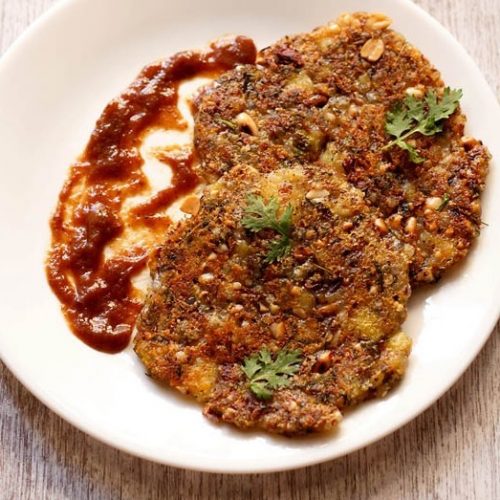
Sabudana Thalipeeth Recipe (Fasting Snack)
Ingredients
- ⅔ cup sabudana (tapioca pearls)
- 2 medium or large potatoes – boiled, peeled and mashed
- ½ teaspoon cumin powder
- 4 tablespoon peanuts – roasted and coarsely ground
- ½ inch ginger – finely chopped or grated
- ¼ cup coriander leaves – chopped
- 1 teaspoon lemon juice
- 1 teaspoon sugar or add as required
- rock salt – edible and food grade (sendha namak), add as required
- peanut oil or ghee as required for pan-frying
Instructions
Soaking sabudana
- Pick and rinse the sabudana well till you get transparent water when rinsing.
- Soak them overnight in enough water in a bowl.
- The next day, drain all the water very well.
- Make sure there is no water in them.
Making sago mixture
- Add the mashed potatoes and all the ingredients to the soaked sabudana. Mix well.
- Heat a non stick frying pan or a well seasoned cast uron skillet or tawa.
- Spread 1 or 2 teaspoon of peanut oil or ghee on the pan.
- Apply some oil on your palms.
- Take some portion from the mixture and flatten it with your palms.
- You can also flatten on a ziplock bag.
Cooking sabudana thalipeeth
- Place the flattened round (thalipeeth) on the frying pan. Keep the heat to medium-low or medium.
- Fry till both sides are golden brown and crisp. Repeat.
- If you have a large pan, you can cook 2 to 3 thalipeeth at the same time.
Serving suggestions
- On fasting days, serve sabudana thalipeeth with any chutney or raita or homemade tomato ketchup made without onions and garlic.
- You can also have it with curd (yogurt) that has been sweetened with some sugar or jaggery.
- For non-fasting days, you can serve with a chutney or raita or tomato ketchup made with onions or garlic.
Notes
- Make sure to soak the sabudana pearls according to their variety and quality, that is, either overnight or for a couple of hours. Soaking of sago pearls helps them to soften and they get mashed easily, when pressed between the fingers.
- It is important to soak the sabudana very well and they should be completely softened and do not have any hardness in the center. Under-soaked sabudana will burst while cooking and also make the thalipeeth hard in texture.
- To avoid a pasty or sticky texture in the dish, drain sabudana very well.
- You have to cook the potatoes until soft, and not overcook as then the thalipeeth mixture will become sticky. Also, drain them well and mash while potatoes are still hot or warm. Then, add lukewarm mashed potatoes to sabudana.
- You can use a stovetop pressure cooker, steamer, pan or Instant Pot to cook the potatoes. Add water, as required depending on the mode of cooking or equipments you use.
- For a spicy taste, add finely chopped green chilies. In place of coriander, you can even add 2 tablespoons mint leaves for a minty flavor.
- For fasting, use peanut oil or ghee to roast or pan-fry the thalipeeth. For non-fasting days, you can use any neutral flavored oil.
- It is best to use a non-stick pan or well-seasoned cast iron skillet to cook these rotis. Using these, you can avoid sticking of the thalipeeth on the pan.
- Make a non-satvik variant of the same recipe by adding some onions, garlic or garlic chives in it. Use regular white salt, instead of rock salt. It makes for a tasty tea/coffee time snack.
- You can easily halve, double or triple this recipe for making smaller or larger batches.
Nutrition Info (Approximate Values)
Sabudana Thalipeeth recipe from the archives was first published on April 2013.













I tried this for the first time today, and it came out really well! Thanks for the recipe! I love your website and have been an ardent fan for the last decade. I just wanted to say I appreciate all the effort and love you put into this blog. Kudos to you and your team. Much love!!
Thanks a lot Namratha. Glad to know. Thanks for the review on the recipe and also for the rating. Take care.
can u use onions also?
shilpa, if making for fasting or vrat then don’t add onions. otherwise you can add onions.
Tried it, Delish!! Thanks for sharing all these fabulous recipes.
welcome nish and thanks.
Hi Dassana, Thanks fr sharing navratras with us.
welcome dhanita 🙂
Hello dassana
This was a really nice one. Thanks for such a creative recipe.
welcome rims
Did you mean 2/3 (=0.66) cup of sabudhana or did u mean to say 2 or 3 cups of sabudhana.. Using 2 potatoes for 0.66 cup sounded so much of potatoes for me.. so just asking it for confirmation.
Thanks Dassana for wonderful recipes.
welcome isshwarya. its 2/3 (=0.66) cup of sabudana.
sabudana thalipeeth was yum.. Thanks for the recipe and keep up the good work!
welcome deep. thanks for your positive review.
Step by step picture demonstration helps to understand, remember things and compare where we are going wrong. Also pictures looks very genuine. Though I have tried this dish, sago turned out to be very sticky. Wish to try it again after reading your recipe.
thanks anna for your appreciation. if you follow this recipe then dish will definitely come out well. as its a tried and tested sabudana recipe.
Hi Dassana,
Again thanks for a lovely recipe. I have few questions though.
Is there any substitute for peanuts. I am allergic to them.
Its really tough to roll them over on pan.. 🙂
Thanks.
hi garima, i can only think of cashewnuts instead of peanuts. however, you can skip the peanuts completely and make the thalipeeth only with potatoes. use a non stick pan when making these. they won’t stick then. to bind and give structure you can also add 1 or 2 tsp of kuttu ka atta, singhare ka atta or ragjira ka atta if making for fasting. otherwise even rice flour or corn flour will also do for non fasting days.
I am fascinated by using tapioca pearls like this; I am more familiar with them in their SE Asian dessert incarnation. This looks really yummy.
Sounds new to me….looks very tempting, beautiful clicks
ohhh i’m gonna love these, I’m fasting and anything with sabudana is like treat for me 🙂
I love the way you play with light in your pictures, the simple Sabudana Thalipeeth is looking stunning.. Applauds !!
thanks nupur.
THIS IS REALLY TESTY